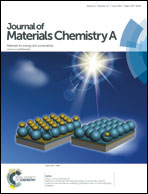Effect of copper metalation of tetrabenzoporphyrin donor material on organic solar cell performance†
Abstract
The effects of copper metalation of tetrabenzoporphyrin on the properties and performance of organic solar cells are studied. Tetrabenzoporphyrin (BP) and copper tetrabenzoporphyrin (CuBP) are both solution processed from soluble precursor materials and thermally converted in the thin film. Despite high field-effect hole mobility above 1 cm2 V−1 s−1, the power conversion efficiency (PCE) of solar cell devices with CuBP is severely diminished compared to those with BP. Conducting atomic force microscopy (c-AFM) is used to show that CuBP films are highly conductive in the direction perpendicular to the substrate, relative to those comprising BP. By analyzing the donor absorption characteristics as well as the external quantum efficiency and short-circuit current density of bilayer OPV devices as a function of donor layer thickness, it is determined that the differences in performance are likely due to a prohibitively short effective exciton diffusion length (LD) in the metalated derivative. By modeling the external quantum efficiency of bilayer OPV devices, we are able to approximate this difference in effective LD to be 15 nm for BP and 2 nm for CuBP.


 Please wait while we load your content...
Please wait while we load your content...